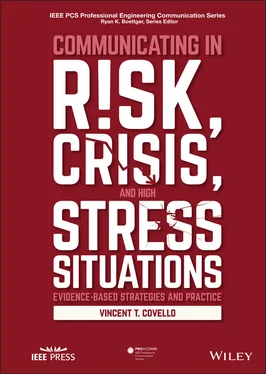Vincent T. Covello - Communicating in Risk, Crisis, and High Stress Situations - Evidence-Based Strategies and Practice
Здесь есть возможность читать онлайн «Vincent T. Covello - Communicating in Risk, Crisis, and High Stress Situations - Evidence-Based Strategies and Practice» — ознакомительный отрывок электронной книги совершенно бесплатно, а после прочтения отрывка купить полную версию. В некоторых случаях можно слушать аудио, скачать через торрент в формате fb2 и присутствует краткое содержание. Жанр: unrecognised, на английском языке. Описание произведения, (предисловие) а так же отзывы посетителей доступны на портале библиотеки ЛибКат.
- Название:Communicating in Risk, Crisis, and High Stress Situations: Evidence-Based Strategies and Practice
- Автор:
- Жанр:
- Год:неизвестен
- ISBN:нет данных
- Рейтинг книги:4 / 5. Голосов: 1
-
Избранное:Добавить в избранное
- Отзывы:
-
Ваша оценка:
- 80
- 1
- 2
- 3
- 4
- 5
Communicating in Risk, Crisis, and High Stress Situations: Evidence-Based Strategies and Practice: краткое содержание, описание и аннотация
Предлагаем к чтению аннотацию, описание, краткое содержание или предисловие (зависит от того, что написал сам автор книги «Communicating in Risk, Crisis, and High Stress Situations: Evidence-Based Strategies and Practice»). Если вы не нашли необходимую информацию о книге — напишите в комментариях, мы постараемся отыскать её.
LEARN THE UNIFYING PRINCIPLES BEHIND RISK, CRISIS, AND HIGH STRESS COMMUNICATION WITH THIS STATE-OF-THE-ART REFERENCE WRITTEN BY A MAJOR LEADER IN THE FIELD Communicating in Risk, Crisis, and High Stress Situations: Evidence-Based Strategies and Practice
Communicating in Risk, Crisis, and High Stress Situations
Communicating in Risk, Crisis, and High Stress Situations: Evidence-Based Strategies and Practice — читать онлайн ознакомительный отрывок
Ниже представлен текст книги, разбитый по страницам. Система сохранения места последней прочитанной страницы, позволяет с удобством читать онлайн бесплатно книгу «Communicating in Risk, Crisis, and High Stress Situations: Evidence-Based Strategies and Practice», без необходимости каждый раз заново искать на чём Вы остановились. Поставьте закладку, и сможете в любой момент перейти на страницу, на которой закончили чтение.
Интервал:
Закладка:
3.2.1 Characteristics and Limitations of Scientific and Technical Data about Risks
One source of difficulty in communicating information about risks is the uncertainty and complexity of the data generated by risk assessments. Risk assessments are the theories and methods used to determine the risks posed by a particular hazard or event that may have a negative impact on individuals, groups, or the environment. Many organizations conduct risk assessments to characterize the nature and magnitude of health, safety, and environmental risks. Organizations also conduct risk assessments to characterize the nature and magnitude of legal and financial risks.
Despite their strengths, risk assessments seldom provide exact answers. Because of limitations in scientific understanding, data, models, and methods, the results of most assessments are approximations. The resources needed to resolve these uncertainties are seldom adequate to the task. Table 3.1lists sources of uncertainty in risk assessments.
Table 3.1 Sources of uncertainty in risk assessments.
| Have the study results or claims been successfully tested using more than one method?Have the results or claims been re‐evaluated using different measurement or statistical techniques?Do the study results or claims test high for statistical significance?Is the probability so small that the same effect could have occurred by chance alone?What is the statistical strength of the study result or claim?How substantial is the strength of association?Are the claims of a strong or clear effect supported by a strong strength of association?Are the study results or claims specific as to health effects of the risk agent or are they general in nature?Can the study results or claims be explained by confounding factors or other relationships?What is the amount of detail in describing data and possible weaknesses in the study?What types of data are missing and how important are the gaps?What variables are missing?How significant are the missing data or variables?What are the greatest sources of uncertainty in the results?What does the investigator feel is known well and what is not known?Are the conclusions clearly stated?Are the conclusions of the study justified by the findings and substantiated by the evidence presented? Which ones are? Which ones are not?Are the conclusions linked to the original objectives of the study?Are the generalizations confined to the populations from which the sample was drawn? If not, why not?What are the implications of the study?What action does the study suggest?What additional studies are needed?Could this study be replicated? If not, why not?Has the study been peer‐reviewed by qualified professionals?Has the study been published or accepted for publication in a scientific journal? If the study has not been submitted for publication in a scientific journal, will it be submitted? |
These uncertainties invariably affect communication. For example, uncertainties in risk assessments often lead to radically different estimates of risk and the outcomes of efforts taken to reduce the severity of the harm or adverse effects. Debates about risks often derive from these uncertainties.
3.2.2 Characteristics and Limitations of Spokespersons in Communicating Information about Risks
Men wanted for hazardous journey. Small wages. Bitter cold. Long months of complete darkness. Safe return doubtful. Honor and recognition in case of success .
— Newspaper ad attributed to Sir Ernest Shackleton to solicit participants for his fateful 1914 Imperial Trans‐Antarctic Expedition.
A central question addressed by risk communication researchers is why some individuals and organizations are trusted as sources of risk information while others are not. The Antarctic expedition leader Sir Ernest Shackleton (quoted above) achieved much of his success and admiration through the high levels of trust he engendered in his expedition crews. He communicated, through both words and actions, essential trust‐building characteristics: listening, caring, empathy, conviction, honesty, and optimism. Shackleton’s risk management and communication skills were vividly demonstrated during the 1914 Imperial Trans‐Antarctic expedition, saving the lives of all 28 crew members after the ship was crushed by ice. Although Shackleton was personally concerned about the outcome, he concealed his anxiety to ensure that it did not spread. He communicated his conviction that the crew would survive and get home. It was a message he repeated frequently.
Unfortunately, many technical, engineering, and scientific professionals, together with government and industry authorities – among the most visible, prominent, and important sources of risk information – lack effective risk communication skills. Leaders, risk managers, and technical experts are frequently insensitive to, or unaware of, the information needs of interested and affected parties.
Numerous examples can be cited. For example, Secretary of Defense Donald Rumsfeld, at a news briefing on weapons of mass destruction in Iraq, famously said:
As we know, there are known knowns; there are things we know we know.
We also know there are known unknowns; that is to say we know there are some things we do not know. But there are also unknown unknowns—the ones we don’t know we don’t know (Secretary of Defense Donald Rumsfeld, 12 February 2002).
In another example, outrage swept through Canada in 2003 when it was revealed the beloved Tim Hortons fast‐food restaurant chain had been freezing its doughnuts rather than serving them fresh, undermining the company’s “Always fresh” marketing motto. A media spokeswoman for the company unwisely said: “Until I confirm or deny anything, it simply doesn’t exist.” Unfortunate statements such as this communicate a lack of caring and undermine trust, key building blocks of effective risk communication.
Despite the vulnerability of a nation’s food supply to terrorism as indicated by the thousands of foodborne illnesses that occur accidentally, Tommy Thompson, in his farewell address as US Secretary of Health and Human Services, shockingly said:
I, for the life of me, cannot understand why the terrorists have not attacked our food supply because it is so easy to do. (Secretary of Health and Human Services Tommy Thompson, 3 Dec. 2004).
Unfortunately, risk communication spokespeople often make similar errors. Many of these errors occur because many risk communications are unplanned. One major result of the lack of communication skills among spokespeople is the loss of trust and credibility in experts and risk management authorities.
Many risk managers and spokespersons lack the skills needed to effectively communicate information about risk. A partial listing of these skills is shown in Tables 3.2– 3.4. As one example, many use complex and difficult technical language and jargon in communicating information about risks to the media and the public. Technical language or jargon is not only difficult to comprehend but creates perceptions that the person is unresponsive, uncaring, or evasive.
Table 3.2 Risk communication skills, traps, and pitfalls.
| Category | Dos | Don'ts |
|---|---|---|
| Jargon, technical terms, and acronyms | Avoid using technical jargon. Define technical terms and acronyms; limit their use and explain those you do or must use. | Do not use undefined jargon, technical terms, or acronyms. |
| Absolutes | Avoid absolutes – never say never in high‐stress situation. | Do not offer guarantees; do not use the terms such as “every” or “all.” |
| Truthfulness | Tell the truth; be open and transparent. | Do not lie or present half‐truths. |
| Negatives | Use positive or neutral terms. | Do not use terms with strong negative associations; do not use highly charged analogies; do not repeat the words used in an allegation. |
| Defensiveness | Respond to issues, not personalities; stay calm and collected. | Do not let your temper interfere with your ability to communicate. |
| Clarity | Confirm understandings. | Do not assume understandings. |
| Visuals | Use graphics, examples, metaphors, and analogies to aid understanding. | Do not talk in abstractions. |
| Attack | Focus attacks on issues. | Do not make peripheral attacks against persons or organizations. |
| Promises | Promise only what you are certain will occur or what you can deliver. | Do not make promises you cannot back up or keep. |
| Speculation | Stick to the facts: state what you know, what you don’t know, and what is being done to answer the question. | Do not discuss extreme worst‐case scenarios. |
| Humor | The benefits of humor are seldom worth the risks in high‐stress situations. | Do not use, as the audience may be offended, may think you are not taking the issue seriously, or may think you don’t care, don’t have empathy, or don’t have compassion. |
| Blame | Accept your fair share of responsibility; focus on how problems can be solved and how challenges can be overcome. | Do not point your finger at others as a means of dodging responsibility. |
| Risk comparisons | Use comparisons to gain perspective; cite trustworthy sources of data; compare the same risk at two different times or circumstances; compare with a standard or regulation that is understood by the listener. | Do not use comparisons for gaining acceptance of a risk. |
Table 3.3Risk communication skills of spokespersons.
Читать дальшеИнтервал:
Закладка:
Похожие книги на «Communicating in Risk, Crisis, and High Stress Situations: Evidence-Based Strategies and Practice»
Представляем Вашему вниманию похожие книги на «Communicating in Risk, Crisis, and High Stress Situations: Evidence-Based Strategies and Practice» списком для выбора. Мы отобрали схожую по названию и смыслу литературу в надежде предоставить читателям больше вариантов отыскать новые, интересные, ещё непрочитанные произведения.
Обсуждение, отзывы о книге «Communicating in Risk, Crisis, and High Stress Situations: Evidence-Based Strategies and Practice» и просто собственные мнения читателей. Оставьте ваши комментарии, напишите, что Вы думаете о произведении, его смысле или главных героях. Укажите что конкретно понравилось, а что нет, и почему Вы так считаете.












